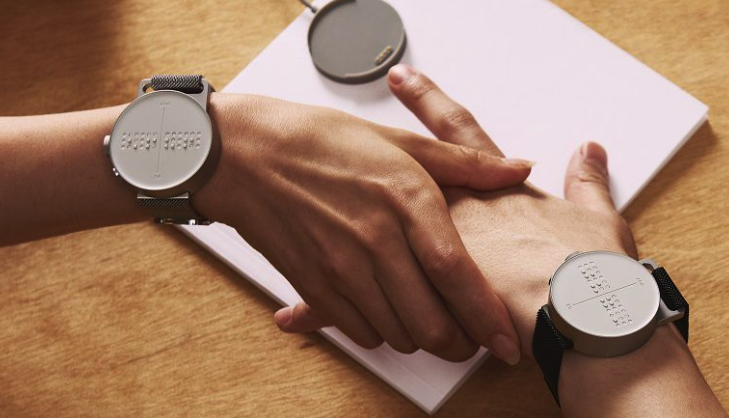PR/IR
News
News
News
- Date
- 2019.01.01 00:00
Wearable technology is not new to the mainstream and adaptive technology markets. AccessWorld reviews this technology, which ranges in price from $39.95 for the Ditto to $599 for an Apple Watch with Cellular, more and more frequently. Like all technology, wearables offer various functions, features, and levels of accessibility.
The subject of this review is a unique entry into the wearable technology market. Unlike any other device in this category, the Dot Watch 2 has a 4-cell braille display. It works with both Android and iOS devices, making notifications from these platforms available to the deafblind. It has some unique functions that allow limited use of the watch without braille knowledge. Though these features will be briefly discussed, the focus of this review will be on the Dot as a companion to a smart phone. Unless otherwise noted, Dot Watch will refer to the second generation. The first generation was discontinued in June 2018.
Dot Watch Packaging and Contents
The Dot Watch arrived in a very plain package. After opening the box, things became more interesting. After removing the plastic from the second box, I received some rather nice tactile surprises in terms of how the watch was packaged. Along the left side of the box, the words "Dot Watch" were embossed in braille. On the right side, the words "Reinventing tactile communication" were written. On that same side, the word "manual" was written in braille on a strip of paper taped to the braille manual. Pulling on this paper opened the box, revealing its contents.
The first item in the box is the manual. Though slightly dated, it covers the basics, complete with tactile graphics of the watch. To get the most up-to-date version of the manual, consult the User Guide found in the mobile app, or the guide on the Dot Incorporation website.
Underneath the manual is the Dot Watch along with the proprietary charger that connects to the bottom of the watch. The Dot comes with the wristband already attached and is ready to wear. The User Guide recommends charging the watch before the first use.
The charger has a magnetic, circular attachment on one end where the bottom of the watch connects, and on the other end a standard USB plug that can be plugged into any power supply. To line up the magnets on the watch and charger, find the small indentation on the bottom of the watch. On the charger, there are three dots forming the braille letter L. Lining up the indentation on the watch with these dots properly aligns the magnets for charging. If the battery is not completely drained, the watch will vibrate to indicate it is charging. If there is no vibration, it's likely the watch battery is completely dead. In this case, wait a few minutes for the battery to charge, then turn the Dot Watch on by pressing and holding the Home button for three seconds.
Description of the Dot Watch
The housing of the Dot Watch is aluminum. It's circular, and about the size of an Apple Watch, though proportioned differently. It's in a 43-millimeter case. On the right side of the watch, there are two buttons on either side of a crown. The crown can be turned clockwise or counterclockwise. With the buttons on the right (I wore the watch on my left wrist), the button closest to you is Home while the other is Select. The Home button puts the watch in Standby mode while the Select button wakes it. A protective cover over the face helps keep debris from entering the 4-cell display. On a slightly lower surface is the 4-cell braille display itself. On the other side of a metal bar that is level with the watch's protective cover, you will find another bar. Behind that, located parallel to cells 2 and 3 are the touch sensors used to pan the display. The sensor under cell 2 pans backward, and the one under cell 3 pans forward.
The wristband that comes with the Dot Watch feels quite elegant. It is made of a magnetic mesh and feels very similar to the Milanese Loop for the Apple Watch. Like the Milanese Loop, the Dot Watch band is secured to your wrist using a magnet.
Waking the Dot Watch
To wake the Dot Watch, press the Select button. The Dot Watch will vibrate, and something resembling braille will be shown on the display, though the user will be unable to make sense of it. Dot Watch operates in two modes: Tactile and Braille. By default, the Tactile mode is enabled, and uses a braille code Dot Incorporation designed themselves. You can read further details in this section of the manual. For example, if the time is 3:00, cell 1 is blank while cell 2 contains 3 pins. Each dot in cells 3 and 4 represents five minutes. While this is a unique concept that works differently when using the Timer and Stopwatch applications, it requires learning a code unique to the watch. To switch between modes on the Dot Watch, press Home, Select, and then Home again.
If you wish, you can switch the Dot Watch's orientation, so it can be worn on your right wrist. To do this, press Home twice followed by two presses of the Select button. Then, press Home twice, and then press and hold Select. If this sounds too complicated, you can switch the orientation using the app once it is paired to your phone.
Pairing the Dot Watch With Your Smart Phone
Before pairing a Dot Watch to a mobile device, first download and install the mobile application. Apps are available for both iOS and Android. Please be aware that you want the Dot Watch 2 application, not the Dot Watch 1 application. This app is compatible with iOS 9 and later and Android version 4.4.4 and later. Note that the Android app will not be reviewed, as I do not own an Android device, though the experience should be similar. I evaluated the Dot using my iPhone 8 running iOS 12.1.1.
After downloading, launch the Dot Watch 2 application and register. After registering, you are ready to pair your Dot Watch. All portions of the Dot Watch app are fully accessible using VoiceOver with speech or braille. I found the pairing process to be simple and straightforward. Please read about how to pair the Dot Watch here. Though there is a way to set the time without being paired to a mobile device, once a connection is established, the Dot Watch will automatically synchronize with your phone, and show the correct time.
The Dot Watch App
After you have registered and paired the Dot Watch, you will be placed in the first of four tabs known as My Watch. The other tabs are Clock, Functions, and Settings.
My Watch
My Watch displays information concerning the watch and your account. The first element welcomes you, and the second shows battery status. You can check the battery status on the Dot Watch by pressing the Select button to wake the device and turning the crown clockwise once. The number will be displayed in braille in Braille mode, and as a series of partially filled cells in Tactile mode.
Settings
It's worth customizing the Dot Watch to your liking as much as possible before using it. Changes to settings are effective immediately, and are confirmed by a vibration from the watch. It is often unnecessary to activate the Back button to save your settings, but should you need to, it is located in the upper left corner of the screen. The first option on the Settings tab welcomes you and allows you to change account information and sign out of your account.
The next option, called "Dot Watch" followed by the last four digits of the serial number, is where most settings are adjusted. The first set of options are found in Output Settings. The first option is Auto Scroll Speed, which adjusts the display's refresh rate. This is adjustable by percentage, though I was not able to set the value above 86 percent. After flicking to the desired speed, double-tap or press a cursor routing button to change the setting. This menu also allows for adjustment of vibration intensity. Once again, I was unable to adjust this value above 86 percent. There is also a picker item to adjust the period of time the Dot Watch waits for activity before going into Standby mode. Again, the picker item would not allow me to set the value to its minimum or maximum. Finally, there is an option to control whether the touch sensors move by one or four cells.
The next series of options are found in Display Settings. The first option is to set the watch mode. The next series of options allows you to customize how the date is displayed by showing either the date or month first. After that, you can adjust how time is displayed. By default, the Dot Watch uses your mobile device's time format, but this can be changed to 12- or 24-hour time. There is also a setting called Reverse Mode, which allows you to wear the Dot Watch on your right wrist.
The next series of options pertain to notifications that are delivered to the Dot Watch. You can turn them on or off, or just turn off specific alerts for phone calls. There is an umbrella setting for all other notifications on iOS. Note that on Android, it is possible to customize app-specific notifications. The only way to do this on iOS is by adjusting the notification settings on your phone. Finally, there are language settings, though this submenu controls more than the language used. This is where you set your braille table and code of braille. Note that the Dot Watch has a 6-dot display, so 8-dot braille is unavailable. Available languages include German, French, English, Spanish, and Korean among others.
The final set of options in this menu allows you to check for software updates, obtain watch-specific information such as the firmware build along with some information about the connected mobile phone, and un-pair the device.
A Support heading on this screen allows you to contact Dot Incorporated, read the User Guide, view a tutorial to familiarize yourself with the watch, read the company's privacy policy, and view the currently installed app version.
Clock
The Clock tab is where you can set alarms and enable the ability to be notified at the top of each hour. You set alarms on the Dot Watch the same way you do in the iPhone's Clock app. If you wish to use the Dot Watch as an alarm, you must set alarms in the app, as the watch will not alert you if the iPhone's alarm goes off.
Functions
The third tab along the bottom is called Functions. These are features that can help you manage the Dot Watch. The first function is Saved Messages. In this section, you can look at any notifications you have saved from the watch on your iOS device. The next function is Study Braille, which allows you to send numbers, letters, or anything typed on your mobile device to the Dot Watch. Someone using Tactile Mode could make use of this feature to hone their braille skills. Memo allows you to write something on your iOS or Android device and have it available on your wrist for reading. This can come in handy when you need to access information quickly, but are unable or unwilling to use your phone and braille display to do so.
Find my Dot Watch is the final function in this tab, and selecting this option will cause the watch to vibrate for 5 minutes. If you have the hearing to utilize this feature, it will assist you in finding a misplaced Dot Watch. You can use the Dot Watch to find your phone, as long as it is within Bluetooth range of the device. Pressing the Home and Select buttons together two times will cause your phone to vibrate and play a tone. This only sends one sound and a one second vibration, but you can hit it as many times as necessary.
Using The Dot Watch
Let's look at how well the Dot Watch performs day-to-day. I spent approximately two weeks with the Dot Watch 2 and integrated it into my life.
Braille Functionality
The braille displayed on the watch utilizes a different kind of technology than that which you may be used to. This technology requires that you do not touch the display as it is refreshing. When you are reading a notification, you must select it, read the four cells, lift your finger, press the touch sensor, and put your finger back on the watch to continue reading. It's a bit of a learning curve for even the most tech-savvy braille user. I sped up the auto scroll speed as much as I could, and it worked fairly reliably once I adjusted to this process. If you do not lift your fingers off the display, as reported by J.J. in his CSUN Article, using certain features that constantly refresh, such as the timer, becomes difficult, because all of the dots may not rise. Perhaps one way to offset this would be to send a vibration after a certain user-defined number of seconds have passed. I did not find that the protective covering interfered with the display, though the pressure of my finger did. When the display had obviously misfired, I would scroll back and then forward, which usually fixed the situation. In a few cases, pressing Home fixed any issues. In very rare cases where I could make no sense of what was displayed, I checked the notification on my iPhone. I had to do this two or three times for every 100 notifications.
Getting Notified
With all notifications enabled, the Dot Watch reliably alerted me to any notifications by vibrating twice. To read notifications on the watch, you press the select button, turn the crown counter-clockwise once to bring up notifications (abbreviated "noti) and then press Select. Pressing Select again will bring up your notifications in reverse chronological order.
While this works reliably, I was hoping for a more complex system like that used by the Ditto. You can set custom vibrations for each app offering notifications. This would come in handy especially in iOS where you either receive all notifications sent to your phone or none. This way, I would know by the vibrations which app was notifying me. If this couldn't be implemented, an option to receive notification of phone calls and SMS messages from select contacts would be quite helpful. From my understanding, you can customize the apps you receive notifications from on Android, but I hope the Dot Incorporation will consider doing something similar to what the Ditto does for iOS users.
The Watch Can Even Tell You The Time!
Checking the time is quick and easy with a press of the Select button. I found this to be much faster than using the Taptic Time feature on the Apple Watch, as the vibrations from that device are very slow. With the Dot Watch, I press Select, and instantly have access to the time instead of having to count vibrations or obtaining it through the very slow Morse Code output.
Please note that when you travel from one time zone to another, as when I traveled from Charlotte to Phoenix, the Dot Watch does not automatically reflect the time zone change. The Dot Watch keeps track of the time internally, and only synchronizes when you first pair the device. You can resolve this by un-pairing and re-pairing the Dot Watch, or by setting the time manually.
Speaking of time, I have found that if I keep the alarm vibration intensity on its highest setting, it never fails to wake me. If you happen to be a heavy sleeper, though, the vibration may not be strong enough. Unlike the Ditto, the Dot Watch will consistently go off for 5 minutes unless you turn it off. The vibrations of the alarm on the Apple watch are certainly more intense, though if you are a deafblind user who relies exclusively on braille, native support for braille displays is not available on the Apple Watch.
Timer and Stopwatch
To get to the Stopwatch, press Select and turn the crown twice to arrive at what the Dot Watch calls "stop." Press Select to open this application, and then press Select again to start counting up. As noted above, easily keeping track of the time elapsed can be an issue due to the technology used in the watch's braille display.
This wasn't quite as big of an issue for the Timer unless you are setting it for a few seconds. Find the Timer (abbreviated "timr") by turning the crown three times and then pressing Select. You set the minutes by using the crown then pressing Select, and the number of seconds in the same way.
Memos
I found this feature to be very helpful when storing a phone number that I had to dictate to Siri. When you invoke Siri, nothing is displayed in braille while it is actively listening for commands, making it impossible to look up a phone number as you dictate.
Battery Life
The battery life on the Dot Watch is very impressive. I can go between seven and eight days without needing to charge it. To check the battery life, press Select, and then turn the crown clockwise one time. This will display the battery status in 10 percent increments. I charged the Dot Watch four days before writing this article, and it is still at 60 percent. If you are someone who relies on the alarm function to wake you up, it is very nice to not have to charge the watch every 36 hours or so, as you must do with the Apple Watch. Granted, the Apple Watch offers a more robust set of features, but if you require braille, some of these are not accessible to you anyway.
Conclusion
Many of the issues I reported above are ones the makers of the Dot Watch have been open about and have noted in the manual. It is good to see a company producing a watch that is fully accessible to the deafblind. From the process of pairing through utilizing the watch in my daily life, I never had to rely on speech to access anything. Four cells is not a lot of braille, but 44 millimeters isn't a lot of text either. Dot Incorporated continues to develop its feature set and continuously shows dedication to their customers. For example, those who had the first generation of the Dot Watch were given a free upgrade to the second generation. For users who require the ability to read notifications on their wrist or for those who wish to have it for privacy reasons, the Dot Watch is worth considering.
Product Information
Product: Dot Watch 2
Manufacturer: Dot Incorporated
Price: $399.00
This article is made possible in part by generous funding from the James H. and Alice Teubert Charitable Trust, Huntington, West Virginia.
Comment on this article.
Related articles:
The Ditto: A Wearable Notification Center for Your Mobile Device By Scott Davert
Raise Your Pulse While Waking Up In The Morning With The TCL Pulse By Scott Davert
More by this author:
New Standards for Braille Displays are on the Horizon
Focusing on Braille: a Review of the Focus 5th Generation Braille Displays From the VFO Group


 Prev
Prev
 Next
Next









